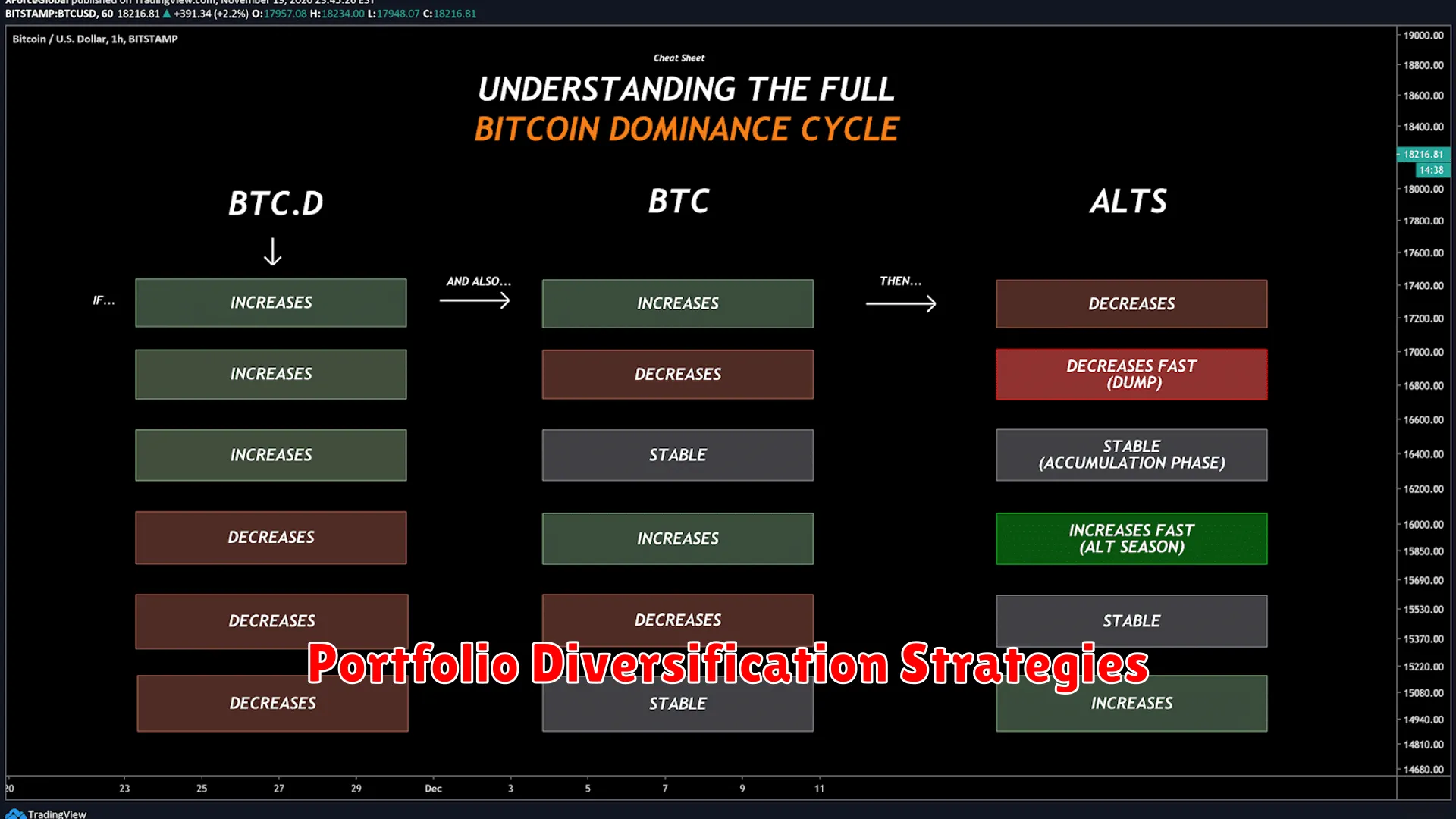Explore the world of cryptocurrencies with a diversified portfolio strategy, transitioning from Bitcoin to alternative coins. Discover how to navigate the evolving crypto market landscape and maximize your investment potential.
The Rise of Cryptocurrencies

In recent years, cryptocurrencies have experienced significant growth and popularity in the financial world. Initially led by Bitcoin, the first decentralized digital currency, the market has expanded to include a wide range of alternative cryptocurrencies, known as altcoins. This diversification has brought about the rise of cryptocurrencies as a new asset class, attracting both individual investors and institutional players.
Bitcoin’s emergence in 2009 marked the beginning of the cryptocurrency revolution. As the pioneer in the field, Bitcoin introduced the concept of blockchain technology, a decentralized ledger system that ensures transparent and secure transactions. Its success paved the way for the development of numerous altcoins, each with its unique features and use cases.
Investors seeking to build a diversified crypto portfolio now have a plethora of options beyond Bitcoin. Altcoins like Ethereum, Litecoin, Ripple, and many others offer different functionalities, including smart contracts, faster transaction speeds, and specialized applications. This variety allows investors to tailor their portfolios to their risk tolerance and investment objectives.
The growth of cryptocurrencies reflects the evolving landscape of finance, with digital assets gaining recognition as legitimate investment opportunities. As the market matures and regulatory frameworks become clearer, more investors are drawn to the potential for high returns and diversification benefits offered by cryptocurrencies.
Bitcoin vs. Altcoins: A Comparison

When it comes to building a diversified crypto portfolio, understanding the differences between Bitcoin and altcoins is crucial. While Bitcoin is the most well-known cryptocurrency and often considered a store of value akin to digital gold, altcoins encompass all other cryptocurrencies apart from Bitcoin. Here is a comparison between the two:
1. Market Dominance:
Bitcoin holds the highest market capitalization and dominance among all cryptocurrencies. Altcoins, on the other hand, represent a diverse range of projects and tokens competing for market share.
2. Volatility and Risk:
Bitcoin, due to its established reputation and large market cap, tends to be less volatile compared to many altcoins. Altcoins, being newer and with varying use cases, often face higher volatility and associated risks.
3. Use Cases and Technology:
While Bitcoin primarily serves as a digital currency and store of value, altcoins offer a wide array of use cases including smart contracts, decentralized finance (DeFi) applications, and unique utility within specific blockchain ecosystems.
4. Regulatory Considerations:
Bitcoin, as the first cryptocurrency, has received more regulatory clarity compared to altcoins. Altcoins may face regulatory uncertainties and changes, impacting their adoption and value.
5. Investment Strategy:
Investors looking to diversify their crypto holdings often consider allocating a portion to both Bitcoin and select altcoins. While Bitcoin can offer stability, altcoins may provide opportunities for higher growth potential but come with increased risk.
Portfolio Diversification Strategies

When delving into the world of cryptocurrencies, crafting a diversified portfolio is essential for managing risk and maximizing potential returns. With the surge in popularity of digital assets like Bitcoin and Altcoins, investors are increasingly looking for ways to spread their investment across multiple tokens to reduce exposure to volatility and capture opportunities across different markets.
Here are some key strategies for diversifying your crypto portfolio:
- Allocation Across Different Cryptocurrencies: Allocate your investment across a variety of cryptocurrencies, including major players like Bitcoin and Ethereum, as well as alternative coins (Altcoins) such as Litecoin, Ripple, and Cardano. This helps spread risk and exposure to different market dynamics.
- Spread Across Market Caps: Consider diversifying across cryptocurrencies with different market capitalizations. While large-cap coins like Bitcoin may offer stability, small or mid-cap tokens can provide growth opportunities but come with higher risks.
- Geographic Diversification: Explore cryptocurrencies from different regions or countries to reduce geopolitical risks. This approach can also expose your portfolio to diverse regulatory environments and market developments.
- Industry Focus: Diversify your crypto holdings across various sectors like decentralized finance (DeFi), gaming, or supply chain management. This approach can hedge against sector-specific risks and capitalize on emerging trends.
- Stablecoins and Hedging: Consider incorporating stablecoins like Tether (USDT) or USD Coin (USDC) to mitigate volatility. Additionally, using hedging strategies such as futures contracts or options can help protect your portfolio from adverse price movements.
By implementing these portfolio diversification strategies, crypto investors can enhance their risk management, take advantage of diverse opportunities in the digital asset space, and build a resilient investment portfolio in the dynamic world of cryptocurrencies.
Risk Management in Crypto

Managing risks is a crucial aspect when delving into the world of cryptocurrencies. As you craft a diversified crypto portfolio, it’s essential to have a robust risk management strategy in place to safeguard your investments.
One key risk management technique is diversification. By spreading your investments across various cryptocurrencies, you can lower the impact of a potential loss from a single asset. This strategy helps mitigate the overall risk in your portfolio.
Another important aspect of risk management in crypto is setting stop-loss orders. These orders allow you to automatically sell a cryptocurrency when its price reaches a predetermined point, helping you limit potential losses. Utilizing stop-loss orders can be a proactive approach to risk management.
Furthermore, staying informed about the market trends and continuously monitoring your portfolio’s performance is vital for effective risk management. By keeping a close eye on the crypto market, you can make informed decisions and adjust your portfolio as needed.
Additionally, considering the volatility of cryptocurrencies is essential in risk management. Understanding the inherent volatility of this market can help you set realistic expectations and implement appropriate risk mitigation strategies.
Monitoring and Rebalancing Your Portfolio

When it comes to crafting a diversified crypto portfolio that includes both Bitcoin and altcoins, monitoring and rebalancing are crucial practices to maintain the desired risk-reward balance and investment objectives. Monitoring involves regularly tracking the performance of your portfolio components, staying informed about market trends, and being aware of any significant developments in the crypto space.
Rebalancing is the process of adjusting the allocations of assets in your portfolio to bring them back to their initial strategic targets. As the cryptocurrency market is known for its volatility, the values of Bitcoin and altcoins can fluctuate significantly, leading to changes in the overall composition of your portfolio. Rebalancing allows you to readjust your holdings to ensure they align with your investment strategy and risk tolerance.
Regularly reviewing the allocation of Bitcoin and altcoins in your portfolio is essential to ensure that it remains diversified and aligned with your investment goals. Consider setting specific thresholds for each cryptocurrency within your portfolio, and rebalance whenever these thresholds are exceeded to maintain your desired asset allocation.
Monitoring and rebalancing your crypto portfolio require a disciplined approach and a deep understanding of the market dynamics. By staying vigilant and actively managing your holdings, you can adapt to market changes, seize opportunities, and optimize the performance of your diversified portfolio.
Conclusion
Diversifying your crypto portfolio from Bitcoin to altcoins can help manage risk and maximize potential returns in the volatile cryptocurrency market.




